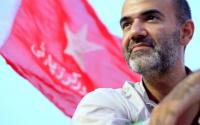Common Dreams / Published on Tuesday, July 26, 2005 by the Inter Press Service
Growing pessimism about averting civil war in Iraq, as well as mounting concerns that the U.S. military presence there may itself be fueling the insurgency and Islamist extremism worldwide, has spurred a spate of new calls for the United States to withdraw its 140,000 troops sooner rather than later.
Although resolutions to establish at least a timeline for withdrawal have so far gained the support of only about a quarter of the members of Congress, the absence of tangible progress in turning back the insurgency is adding to fears on Capitol Hill that the administration's hopes of stabilizing the situation, let alone giving birth to a pro-western democracy in the heart of the Arab world, are delusory.
”In January, we had Congressional staff hanging up on us when we called to say that we want to discuss shifting U.S. policy from more guns and more troops towards withdrawal,” said Jim Cason, communications director of the Friends Committee on National Legislation, a lobby group. ”Now they want to talk about it.”
While the George W. Bush administration still insists that civil war will be avoided and current negotiations to produce a new constitution by the middle of next month remain on track, the continuing high level of violence and the strength and sophistication of predominantly Sunni insurgents and foreign fighters are clearly having an effect here.
That was made clearest in two New York Times articles published Sunday, including one entitled ”Defying U.S. Efforts, Guerrillas in Iraq Refocus and Strengthen,” and another, by John Burns, a veteran star Times reporter who has spent considerable time in Iraq, entitled ”If It's Civil War, Do We Know It?”
The latter story recounted the recent intensification of Sunni violence against the Shia community that provoked even the ever-patient Shia religious leader, Ayatollah Ali Sistani, to whom Washington has increasingly deferred in guiding the political transition, to call on the Shiite-led government to ”defend the country against mass annihilation.”
”From the moment American troops crossed the border 28 months ago,” Burns wrote, ”the specter hanging over the American enterprise here has been that Iraq, freedom (Saddam) Hussein's tyranny, might prove to be so fractured...that would spiral inexorably into civil war.”
”Now, events are pointing more than ever to the possibility that the nightmare could come true,” according to Burns, who noted that Shiite militias and Shiite and Kurdish-led army and police units were themselves taking increasingly aggressive counter-measures, including abducting, torturing, and executing suspected insurgents and their perceived sympathizers and defenders.
The second story, by two other Baghdad-based Times correspondents, quoted unnamed senior military officers reiterating two big frustrations that have been heard since July, 2003: that the insurgency appears to be ”growing more violent, more resilient and more sophisticated than ever,” and that prosecuting the war is like sowing dragons' teeth.
”We are capturing or killing a lot of insurgents,” one ”senior (U.S.) Army intelligence officer,” told the Times. ”But they're being replaced quicker than we can interdict their operations. There is always another insurgent ready to step up and take charge.”
Such assessments are spurring what rapidly has become a cottage industry -- particularly from the Democratic side of the political spectrum -- one fueled in part by the leak in early July of a British contingency plan that called for halving the number of U.S. and British troops in Iraq by the latter part of 2006.
Thus, on July 15, former Central Intelligence Agency director John Deutch published a column in the Times calling for a ”prompt withdrawal plan,” with the initial drawdown set to coincide with the Iraqi elections scheduled for Dec. 15, that would include a timetable for reducing the scope of military operations, while maintaining a ”regional quick-reaction force” in reserve, as well as ongoing intelligence and training programs.
At the same time, the U.S. would urge the Iraqi government and its neighbors to recognize their common interest in Baghdad's peaceful evolution without external intervention and commit itself to an economic assistance program to Iraq ”so long as it stays on a peaceful path” and to the wider region that will encourage cooperation.
A more detailed plan emerged several days later from the Boston-based Project on Defense Alternatives (PDA) calling for complete withdrawal, except for the retention of a multi-national civilian and military monitoring and training contingent of less than 10,000 (of which the U.S. military presence would be limited to 2,000 troops), by September 2006.
The plan, to take effect Aug. 1, would begin with the adoption of a withdrawal time line, a sharp de-escalation of the war in Sunni areas, a shift of U.S. resources to its training mission, and the transfer of foreign military control of localities to elected officials ”without the interference of federal or coalition authorities.”
”The key to enabling total U.S. troop withdrawal from Iraq within 400 days is achieving a political accord with Sunni leaders at all levels and with Iraq's neighbors -- especially Syria and Iran,” according to the report by defense analyst Carl Conetta. ”The proximal aim would be to immediately lower the level of conflict inside Iraq by constricting both active and passive support for the insurgency, inside and outside the country.”
Like the two other authors, veteran Middle East analyst Helena Cobban also believes that the continued U.S. military presence in Iraq is counter-productive to longer-term U.S. interests and is effectively fueling the insurgency. But she goes further than the other two authors, calling for a withdrawal strategy that is ”total, speedy, and generous to the Iraqi people.”
Her model is Israel's 2000 exit from southern Lebanon, noting that, despite deep fears that that withdrawal would touch off ”mayhem and revenge (in Lebanon), none came to pass.”
A prior announcement of ”imminent total withdrawal” would serve to ”focus the minds of Iraqis considerably,” particularly on reconstruction if the U.S. and other countries are sufficiently generous, and ”make them far less hospitable to insurgents, especially those who get their impetus from the prospect of a prolonged foreign occupation.”
All the authors take issue with the conventional assumption that the U.S. military presence is a stabilizing factor without which Iraq's descent into civil war would be more certain or bloody.
They also argue that the administration's argument that Washington's global ”credibility” is outweighed by other considerations, including the damage that the continued U.S. presence does to U.S. interests in the Arab and Islamic world more generally and the reduced ability of the U.S. to deal with other important security challenges while it remains bogged down in Iraq.
As noted by Deutch, continued investment in a losing proposition could result in ”an even worse loss of credibility down the road.”






